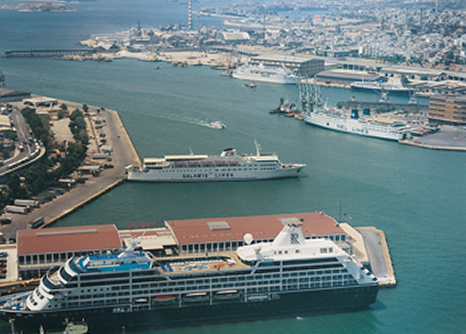PORT OF PIRAEUS / ATHENS - GREECE - EUROPE
PORT INFORMATION

Photo courtesy Piraeus Port Authority SA
Athens is the oldest city in Europe, and for good reason known as the cradle of western civilization. Yet it is far from being a city of only ancient ruins and history. Once the world’s biggest center for the arts and learning, the birthplace of Socrates and home to Plato’s Academy and Aristotle’ Lyceum, it is now a bustling and cosmopolitan metropolis. Athens wears its cloak of history and heritage comfortably, weaving symbols like the Acropolis, Byzantine churches, ancient monuments, traditional tavernas, and toppled columns seamlessly with avant-garde infrastructures and a modern underground system, technological innovations, art galleries and exciting nightlife.
Cruise Terminals at the Port of Piraeus - Athens
Over 20 million passengers pass through the Port of Piraeus each year, making it the biggest and busiest harbor in the Mediterranean. Located in the south-western Aegean Sea on the southernmost peninsula of mainland Greece the Port of Piraeus is only about 7 miles from the centre of Athens.
The cruise ships dock in Megas Limani, one of three harbors that form the Port of Piraeus, at Cruise Terminal A or Cruise Terminal B. Cruise Terminal A is in the middle of the harbour and Cruise Terminal B is at the entrance of the harbour. Equipped with eleven berths, the docking facilities can handle even the largest cruise ships like the Queen Mary II and Royal Caribbean’s Freedom of the Seas. There are two actual terminals.
The cruise terminals are about 30 minutes from Athens International Airport and can be reached by the Metro train route that takes about 75 minutes (Line 3 to Monastiraki, Line 1 to Piraeus), by the hourly bus to the Piraeus city centre and then a bus to the port, or by taxi.
Open-air parking is available for personal vehicles.
The cruise terminals are just a short walk from the centre of Piraeus where a train can be taken to the heart of Athens. There are also two buses operating the route between Piraeus and Athens. The buses, 040 and 049, leave and arrive every 20 minutes at a stop between the two terminals.
Cruise Lines using the Port of Piraeus Cruise Terminals as an Embarkation / Disembarking Ports
Most of the major cruise lines use the Port of Piraeus as either their port of embarkation or disembarking for cruises beginning in Athens. These include Azamara Club Cruises, Crystal Cruises, Hapag-Lloyd Cruises, Oceania Cruises, P&O Cruises, Princess Cruises, Regent Seven Seas Cruises, Seabourn, SeaDream Yacht Club, Silversea Cruises, Windstar CruisesMust See Attractions in Athens, Greece
Piraeus has served as the port city of classical Athens for some 2,500 years. The Archaeological Museum of Piraeus and the Municipal Gallery of Piraeus, not far from the cruise terminal, are worth a visit. But generally cruise passengers are anxious to head for Athens some 12 kilometres away.
Athens Acropolis: Visible from almost every corner of the city, the Acropolis dominates the Athenian skyline. The new Acropolis Museum with its unique horde of treasures from ancient Greece is about 300 metres from the Acropolis and about 2 km. from the centre of Athens. The museum is directly linked to the Athens Metro by the Acropolis Station. Try to go before 9am to avoid the crowds and the heat.
Plaka District: Just down from the Acropolis is the Plaka District, an old neighborhood full of small cafes, tavernas and souvenir stores and famous for its neoclassical architecture. This area is made up of colourful winding pedestrian streets. A visit to the Plaka is almost a given after a visit to the Acropolis, relaxing in one of the sidewalk cafes enjoying a local dish and some ouzo. You can do the Acropolis and Plaka district on your own by using the train from Piraeus.
Ancient Athens: Monuments can be found all around the city center, side by side with contemporary constructions. Archaeological sites have been perfectly integrated into the contemporary city. Walk in Athens or sit for a coffee and at the same time enjoy major sites of antiquity such as the Ancient Agora, the Roman Agora and others.
Museums: There are important institutions in Athens hosting world treasures from antiquity and the Byzantine era. These include the Acropolis Museum, the National Archaeological Museum, the Museum of Cycladic Art, the Benaki Museum and the Byzantine Museum. Next to them, there are a number of state thematic museums such as the Museum of Contemporary Art and the War Museum.
